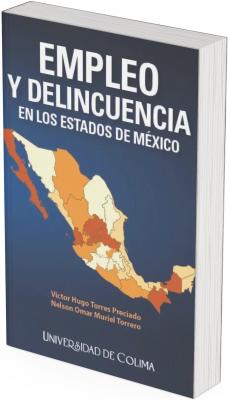Empleo y delincuencia en los estados de México
Keywords:
Employment, delinquency, studies, technical analysis, temporary and spatial diemensionSynopsis
The authors of this work study the relation between economy and delinquency in the various states of Mexico with an emphasis on thefts of property, a type of offense that through various channels “may potentially affect the functioning of an economy, since while theft towards passers-by may modify the patterns of consumption of an individual or a home, thefts towards businesses, on the other hand, may skew the investment plans of a business.” One of their contributions consists of clarifying the behavior of offenses against property in all 32 states of Mexico when they are conditioned to the types of use in violence, and the segmentation that prevails in the Mexican labor market. Among the different findings, we have, for example, that theft committed against passers-by describe a dynamic towards the concentration in the highest levels of incidence when they are carried out with violence; that the procyclical co-movement represents the behavior that prevails in most of the states of the country in the different categories of the studied offenses; and that the dissuasive effect of employment increases in the mid-term in most of the patrimonial offenses, particularly when the offenses are carried out with violence. Aside from the contribution that this work means to empirical literature that studies the link between economy and delinquency, it also provides information relevant to design, evaluation, and implementation of strategies and measures of policy of public security focused on reducing offenses against property.
Downloads
References
Allan, E. A. y Steffenmeiser, D. J. (1989). Youth, underemployment, and property crime: Differential effects of job availability and job quality on juvenile and young adult arrest rates. American Sociological Review, 54, 107-123. https://doi.org/10.2307/2095665
Aguayo, E. y Medellín, S. (2014). Dependencia espacial de la delicuencia en Monterrey, México. Ecos de Economía, 18(38), 63-92. https://doi.org/10.17230/ecos.2014.38.3
Anselin, L. (1988). Spatial Econometrics: Methods and Models. Dordrecht: Springer Science+Business Media. https://doi.org/10.1007/978-94-015-7799-1
Arvanites, T. y Defina, R. (2006). Business cycle and Street crime. Criminology, 44(1), 139-164. https://doi.org/10.1111/j.1745-9125.2006.00045.x
Avio, K. A. (1978). The supply of property offenses in Ontario: Evidence on the deterrent effect of punishment. The Canadian Journal of Economics, 11, 1-9. https://doi.org/10.2307/134543
Bebchuck, L. A. (1992). Optimal sanctions when individuals are imperfectly informed about the probability of apprehension. Journal of Legal Studies, 21, 365-370. https://doi.org/10.1086/467910
Becker, G. (1968). Crime and Punishment: An economic approach. Journal of Political Economy, 76(2), 169-217. https://doi.org/10.1086/259394
Block, M. y Heinecke, J. (1975). A Labor Theoretic Analysis of the Criminal Choice. The American Economic Review, 65(3), 314-325.
Britt, C. L. (1995). Reconsidering the Unemployment and Crime Relationship: Variation by age group and historical period. Journal of Quantitative Criminology, 13(4), 405-428. https://doi.org/10.1007/BF02221048
Cantor, D. y Land, L. C. (1985). Unemployment and crime rates in the Post -World War II United States: A theoretical and empirical analysis.American Sociological Review, 50, 317-323. https://doi.org/10.2307/2095542
Chamberlain, G. y Rothschild, M. (1983). Arbitrage Factor Structure, and MeanVariance Analysis of Large Asset Markets. Econometrica, 51, 1281-1304. https://doi.org/10.2307/1912275
Chirikos, T. (1987). Rates of Crime and Unemployment: An Analysis of Aggregate Research Evidence. Social Problems, 34(2), 187-212. https://doi.org/10.1525/sp.1987.34.2.03a00060
CONAPO (2021). Consejo Nacional de Población. Gobierno de México: https://www.gob.mx/conapo/acciones-y-programas/conciliacion-demografica-de-mexico-1950-2015-y-proyecciones-de-la-poblacion-de-mexico-y-de-las-entidades-federativas-2016-2050
Cook, P. J. (1983). Costs of Crime. Encyclopedia of crime and justice, 1, 373-378.
Cortez, W. e Islas-Camargo, A. (2017). Delincuencia, pobreza y crecimiento económico en México, ¿existe una relación asimétrica? MPRA Paper.
Detotto, C., Otranto, E. (2012). Cycles in Crime and Economy: Leading, Lagging and Coincident Behaviors. Journal of Quantitative Criminology, 28, 295-317. https://doi.org/10.1007/s10940-011-9139-5
Ehrlich, I. (1973). Participation in Illegitimate Activities: A Theoretical and Empirical Investigation. Journal of Political Economy, 81(3), 521-565. https://doi.org/10.1086/260058
Enamorado, T., López-Calva, L., Rodríguez-Castelán, C. y Winkler, H. (2016). Income inequality and violent crime: Evidence from Mexico's drug war. Journal of Development Economics, 120, 128-143. https://doi.org/10.1016/j.jdeveco.2015.12.004
Feliz, R. (2012) Crimen y crecimiento económico en México. Los estados federales en el periodo 2003-2010. En J. Aguilar (ed.) Las bases sociales del crimen organizado y la violencia en México. México: Centro de Investigación y Estudios en Seguridad, Secretaría de Seguridad Pública.
Forni, M., Hallin, M., Lippi, M. y Reichlin, L. (2005). The Generalized Dynamic Factor Model: One-Sided Estimation and Forecasting. Journal of the American Statistical Association, 100, 830-839. https://doi.org/10.1198/016214504000002050
Greenberg, D. (2001). Time Series Analysis of Crime Rates. Journal of Quantitative Criminology, 17(14), 291-327. https://doi.org/10.1023/A:1012507119569
Heineke, J. M. (1978). Economic Models of Criminal Behavior. Amsterdam: North Holland.
Indice de Paz México. (abril de 2020). Obtenido de indicedepazmexico.org
INEGI (2020). Censo Nacional de Gobierno, Seguridad Pública y Sistema Penitenciario Estatales. Obtenido de https://www.inegi.org.mx/programas/cngspspe/2020/
INEGI (2020). Encuesta Nacional de Victimización y Percepción sobre Seguridad Pública. Obtenido de INEGI: https://www.inegi.org.mx/programas/envipe/2020/
INEGI (2002). Guía de conceptos, uso e interpretación de la estadística sobre la fuerza laboral en México. Aguascalientes.
Jaitman, L., Caprirolo, D., Granguillhome, R., et al. (2017). The Costs of Crime and Violence: New Evidence and Insights in Latin America and the Caribbean . Inter-American Development Bank. https://doi.org/10.18235/0000615
Jaitman, L., Soares, R., Olavarría-Gambi, M. y Guerrero Compeán, R. (2015). The Welfare Costs of Crime and Violence in Latin America and the Caribbean. Inter-American Develpment Bank. https://doi.org/10.18235/0000170
Kang, W. y Rey, S. (2018). Conditional and Joint Tests for Spatial Effects in Discrete Markov Chain Models of Regional Income Distribution Dynamics. The Annals of Regional Science 61(1), 73-93. https://doi.org/10.1007/s00168-017-0859-9
Kleck, G. y Jackson, D. (2016). What Kind of Joblessness Affects Crime? A National Case-Control Study of Serious Property Crime. Journal of Quantitative Criminology, 32(4), 489-513. https://doi.org/10.1007/s10940-016-9282-0
Loueiro, A. (2013). Essays on Crime, Hysteresis, Poverty, and Conditional Cash Transfers. (P. Dissertatioon, Ed.) The University of Edhimburg. Lütkepohl, H. (2005). New Introduction to Multiple Time Series Analysis. New York: Springer Verlag.
Mocan, N. y Bali, T. (2005). Asymmetric Crime Cycles. National Bureau of Economic Research Working Papers(11210). https://doi.org/10.3386/w11210
Muriel, N. y Cortez, W. (2019). Oportunidad y motivación criminal en México: Un estudio con econometría espacial. En C. Figueroa, y Á. Grijalva, Análisis econométrico del delito y la violencia en México. De las personas a las instituciones (págs. 143-168). Universidad de Guadalajara.
Ordermord, P. A. (2003). Non-linear modeling of burglary and violent crime in the UK. Home Office Section B(80).
Partida, V. (2017). Conciliación demográfica de México 1950-2015. México: CONAPO.
Partida, V., y V., G. (2018). Proyecciones de la población de México y de las entidades federativas 2016-2050. México: CONAPO.
Paternoster, R. y Bushway, S. (2001). Theoretical and empirical work on the
relationship between unemployment and crime. Journal of Quantitative Criminology, 17, 391-402.
Pedroni, P. (2013). Structural Panel VARs. Econometrics, 2, 180-216. https://doi.org/10.3390/econometrics1020180
Ramírez de Garay, L. D. (2014). Crimen y economía: análisis de la tasa de homicidio en México a partir de variables económicas (2000, 2005, 2010). Estudios Sociológicos, XXXII(96), 505-540.
Raphael, S. y WinterEmber, R. (2001). Identifying the Effect of Unemployment on Crime. The Journal of Law and Economics, 44(1), 259-283. https://doi.org/10.1086/320275
Schmidt, P., Witte, A. y Rossi, P. (1984). An Economic Analysis of Crime and Justice. Academic Press.
SESNSP, S. E. (2021). Incidencia Delictiva del Fuero Común. Obtenido de: https://www.gob.mx/sesnsp/es/articulos/incidencia-delictiva?idiom=es
Soares, R. y Naritomi, J. (2010). Understanding High Crime Rates in Latin America: The Role of Social and Policy Factors. En R. Di Tella, E. S, y E. Schargrodsky, The Economics of Crime: Lessons for and from Latin America. University of Chicago Press. https://doi.org/10.7208/chicago/9780226153766.003.0002
Soria-Romo, R. (2018). Una estimación del costo de la inseguridad y la delincuencia en México: Análisis comparativo a nivel de las entidades federativas. Gestión y política pública, 27(1).
Stock, J. y Watson, M. (2002). Forecasting Using Principal Components from a Large Number of Predictors. 97, 1167-1179. https://doi.org/10.1198/016214502388618960
Torres-Preciado, V., Polanco-Gaytán, M. y Tinoco-Zermeño, M. (2017). Crime and regional economic growth in Mexico: A spatial perspective. Papers in Regional Science, 96(3), 477-494. https://doi.org/10.1111/pirs.12205
Verdugo-Yepes, C., Pedroni, P. y Hu, X. (2015). Crime and the Economy in Mexican States: Heterogeneous Panel Estimates (1993-2012). IMF working papers(WP/15/121). https://doi.org/10.5089/9781513541969.001
Vilalta, C. (2011). El robo de vehículos en la ciudad de México. Patrones espaciales y series de tiempo. Gestión y Política Pública 20(1), 97-139.
Wolpin, K. (1980). Time Series/Cross Section Analysis of International Variation in Crime and Punishment. Review of Economics and Statistics, 62(3), 417-423. https://doi.org/10.2307/1927109

Downloads
Published
Series
Categories
License

This work is licensed under a Creative Commons Attribution-NonCommercial-ShareAlike 4.0 International License.







